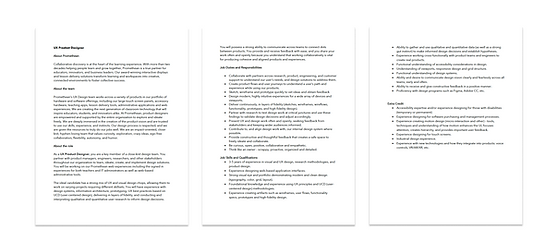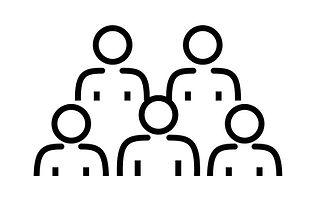Hiring Process

Summary
In the winter of 2023 we were looking to expand the team as we were stretched thin with the volume and depth of our current initiatives. We worked with our in-house recruiters to expand the team, but using a more UX-focused process than was traditional. Here's what that looked like.
Company
Promethean World
Role
Hiring Manager
Timeline
Winter 2023
WHAT
A process to narrow down candidates to find the perfect fit for our team
WHERE
Remote, but ideally within an hour of Pacific Standard Time
WHO
The best possible UX designer for our team and our project focus
WHY
To expand our team capacity and make sure all initiatives got the attention they deserved
Characteristics
We started with a brainstorming session where we identified all the characteristics we were looking for in a new team member. The existing team was involved in this process as it affected all of us. Once the brain dump was complete, we then grouped them into similar categories to find our main themes.

Job Description
The characteristics then informed the creation of the job description that included characteristics we were looking for in addition to the needs of the business and what would be expected of a person in that role.

Applications
Then the floodgates opened and we had over 700 applicants in about 3 days. I asked the recruiter to take down the job listing to allow us to sift through and evaluate.

Initial Filters
The first few passes to narrow down applicants were based on first impression, location, and experience. Location was due to our meeting requirements as a global company and wanting to make sure we had enough overlap time for collaboration. Our applicant tracking tool (Lever) didn't allow for such automated filtered by location or time zone, so it was done manually. In the pursuit for the right person, sometimes these things need to be done. (I viewed so many people on LinkedIn to determine their location that I was flagged.)

Portfolio Review
That left 90 applicants. I enlisted others on the UX team to help review them, but found that we needed a standard by which we were judging them. So I developed the portfolio report card. It was used to evaluate each portfolio using the same criteria. Portfolio work was judged on:
• Design thinking & curiosity
• Logic and problem solving
• Design eye & attention to detail
• Communication & organization
• Solving a real user problem & showing process
Portfolios were evaluated by myself and 3 other team members. From the 90 candidates, we narrowed it down to 8 promising ones we wanted to talk with further. Of those 2 were eliminated by our recruiters phone screening.

Hiring Manager Screenings
For those remaining 6 candidates, the original criteria was used to derive questions that would evaluate that criteria.


Team Review
The top 2 applicants moved on to a portfolio review with the entire UX team. It was a one hour session and the applicant was asked to spend about 45 minutes walking us through 2-3 of their projects and then the 15 minutes at the end was left for questions. Each team member then rated the candidate in Lever.
If the portfolio review went well, then the candidate did a loop with the greater team including project managers and engineering to get a few more perspectives.

Hire!
After the interview loops there was a clear best choice in terms of background, ability, and rounding out the team's competencies. Hiring from that point went very smoothly and the new hire went on to do some amazing work!
They don't all go this smoothly and I've been through some hiring processes that were much rougher than this one. But this time I really dedicated the time and attention needed and made it a focus instead of just one more thing on a packed agenda. In the long run it made all the difference.



